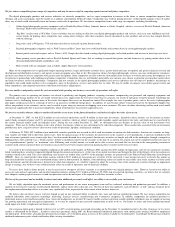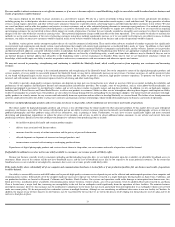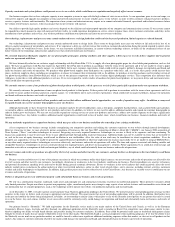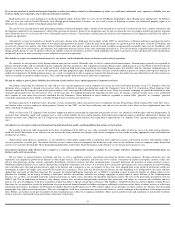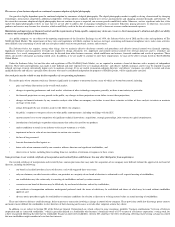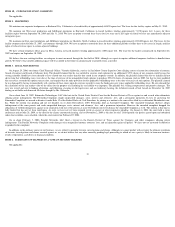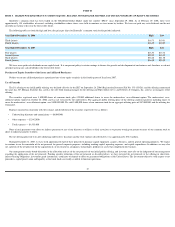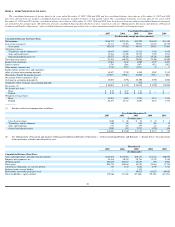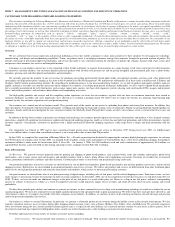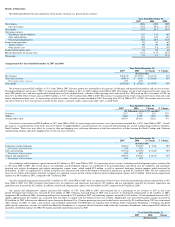Shutterfly 2008 Annual Report Download - page 25
Download and view the complete annual report
Please find page 25 of the 2008 Shutterfly annual report below. You can navigate through the pages in the report by either clicking on the pages listed below, or by using the keyword search tool below to find specific information within the annual report.
The success of our business depends on continued consumer adoption of digital photography
Our growth is highly dependent upon the continued adoption by consumers of digital photography. The digital photography market is rapidly evolving, characterized by changing
technologies, intense price competition, additional competitors, evolving industry standards, frequent new service announcements and changing consumer demands and behaviors. To
the extent that consumer adoption of digital photography does not continue to grow as expected, our revenue growth would likely suffer. Moreover, we face significant risks that, if the
market for digital photography evolves in ways that we are not able to address due to changing technologies or consumer behaviors, pricing pressures, or otherwise, our current
products and services may become less attractive, which would likely result in the loss of customers, as well as lower net revenues and/or increased expenses.
Maintaining and improving our financial controls and the requirements of being a public company may strain our resources, divert management
’
s attention and affect our ability
to attract and retain qualified board members.
As a public company, we are subject to the reporting requirements of the Securities Exchange Act of 1934, the Sarbanes-
Oxley Act of 2002 and the rules and regulations of The
NASDAQ Stock Market. The requirements of these rules and regulations will likely continue to increase our legal, accounting and financial compliance costs, make some activities
more difficult, time-consuming or costly and may also place undue strain on our personnel, systems and resources.
The Sarbanes-
Oxley Act requires, among other things, that we maintain effective disclosure controls and procedures and effective internal control over financial reporting.
Significant resources and management oversight are required to design, document, test, implement and monitor internal control over relevant processes and to, remediate any
deficiencies. As a result, management’
s attention may be diverted from other business concerns, which could harm our business, financial condition and results of operations. These
efforts also involve substantial accounting related costs. In addition, if we are unable to continue to meet these requirements, we may not be able to remain listed on The NASDAQ
Global Market.
Under the Sarbanes-
Oxley Act and the rules and regulations of The NASDAQ Stock Market, we are required to maintain a board of directors with a majority of independent
directors. These rules and regulations may make it more difficult and more expensive for us to maintain directors’ and officers’
liability insurance, and we may be required to accept
reduced coverage or incur substantially higher costs to maintain coverage. If we are unable to maintain adequate directors’ and officers’
insurance, our ability to recruit and retain
qualified directors and officers, especially those directors who may be considered independent for purposes of NASDAQ rules, will be significantly curtailed.
Our stock price may be volatile or may decline regardless of our operating performance.
The market price of our common stock may fluctuate significantly in response to numerous factors, many of which are beyond our control, including:
Some provisions in our restated certificate of incorporation and restated bylaws and Delaware law may deter third parties from acquiring us.
Our restated certificate of incorporation and restated bylaws contain provisions that may make the acquisition of our company more difficult without the approval of our board of
directors, including the following:
These anti-
takeover defenses could discourage, delay or prevent a transaction involving a change in control of our company. These provisions could also discourage proxy contests
and make it more difficult for stockholders to elect directors of their choosing and to cause us to take other corporate actions they desire.
In addition, we are subject to Section 203 of the Delaware General Corporation Law, which, subject to some exceptions, prohibits “business combinations”
between a Delaware
corporation and an “interested stockholder,” which is generally defined as a stockholder who becomes a beneficial owner of 15% or more of a Delaware corporation’
s voting stock, for
a three-
year period following the date that the stockholder became an interested stockholder. Section 203 could have the effect of delaying, deferring or preventing a change in control
that our stockholders might consider to be in their best interests.
•
price and volume fluctuations in the overall stock market;
•
changes in operating performance and stock market valuations of other technology companies generally, or those in our industry in particular;
•
the financial projections we may provide to the public, any changes in these projections or our failure to meet these projections;
•
changes in financial estimates by any securities analysts who follow our company, our failure to meet these estimates or failure of those analysts to initiate or maintain
coverage of our stock;
•
ratings downgrades by any securities analysts who follow our company;
•
the public
’
s response to our press releases or other public announcements, including our filings with the SEC;
•
announcements by us or our competitors of significant technical innovations, acquisitions, strategic partnerships, joint ventures or capital commitments;
•
introduction of technologies or product enhancements that reduce the need for our products;
•
market conditions or trends in our industry or the macro
-
economy as a whole;
•
impairment or loss in value of our investments in auction rate securities;
•
the loss of key personnel;
•
lawsuits threatened or filed against us;
•
future sales of our common stock by our executive officers, directors and significant stockholders; and
•
other events or factors, including those resulting from war, incidents of terrorism or responses to these events.
•
our board is classified into three classes of directors, each with staggered three
-
year terms;
•
only our chairman, our chief executive officer, our president, or a majority of our board of directors is authorized to call a special meeting of stockholders;
•
our stockholders may take action only at a meeting of stockholders and not by written consent;
•
vacancies on our board of directors may be filled only by our board of directors and not by stockholders;
•
our certificate of incorporation authorizes undesignated preferred stock, the terms of which may be established and shares of which may be issued without stockholder
approval; and
•
advance notice procedures apply for stockholders to nominate candidates for election as directors or to bring matters before an annual meeting of stockholders.





